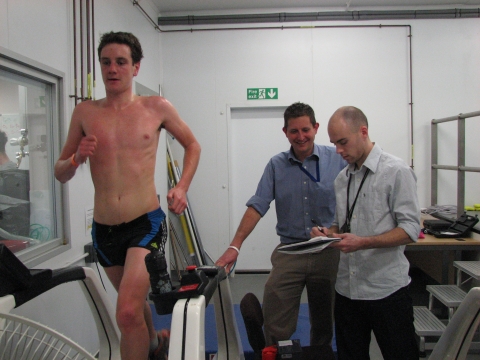

The Extreme Environments Laboratory (EEL) is celebrating 25 years of contributing to the income, output and reputation of the University. Professor Mike Tipton tells us more about this world-renowned facility.
The Extreme Environments Laboratory (EEL) in the School of Sport, Health & Exercise Science is home to the world-renowned Extreme Environments research group, which investigates the physiological and psychological responses to adverse environments (e.g. heat, cold, and hypoxia) and the preparation and protection of those who enter such environments.
On 1 April 1998, the Human & Applied Physiology Group (Clare Eglin, Frank Golden, Igor Mekjavic & Mike Tipton) from Surrey University joined the recently formed Sports Science Department of the University of Portsmouth, nearly doubling its 6 members of academic staff. At the time, the department was spread over four floors of the old St Michael’s Building and had no proper research labs.
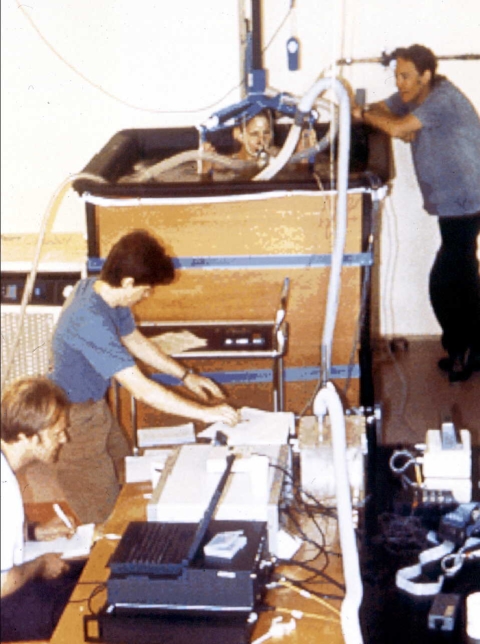
The original EEL (left to right) Jon Dalzell, Clare Eglin, participant, Jon Brooks.
The group had established a climatic chamber in Surrey and were regularly using one at the Institute of Naval Medicine (INM) in Gosport and, occasionally, labs in Slovenia and Sweden. A climate chamber was now needed in Portsmouth. The group were given an ex-chemistry lab on the 1st floor, complete with benches and gas supply; £15,000 later the lab had been emptied!
As luck would have it, the father of one of the two PhD students at the time, Jon Brooks, was a carpenter and built us a small environmental chamber with the help of the other student Jon Dalzell. Prima Refrigeration, who we knew from the INM, gifted a cooling unit that would chill air and water, so we built a small immersion facility from marine plywood and a pond liner. A heater enabled temperature control and studies in heat. The chamber, which we call the Extreme Environments Laboratory (EEL), had a temperature range of between about 10 and 40 °C air temperature, and 5 and 25 °C water temperature. There was only limited humidity control and air movement, but it allowed us to do most of what we wanted, and to start attracting funding.
David Wright, the Science Faculty laboratory manager, was shown EEL when it was completed and was horrified. But he was supportive and comforted by the fact that if the tank of water went through the roof it would land in the road below rather than in an office.
The 'new' extreme environments lab
The income generated by EEL, its popularity and use by students, and the publicity it generated meant that a replacement facility was planned into the new, bespoke “Spinnaker” building for Sport & Exercise Science, opened by Dr Mike Stroud on 8 March 2007, we had also worked with Mike on several of his expeditions.
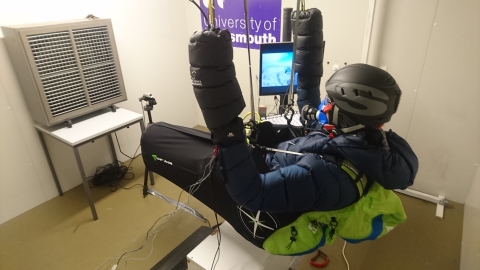
Fiennes Chamber is named after Sir Ranulph Fiennes, the 'world's greatest living explorer' and Portsmouth honorary degree recipient, 2000.
The “new” EEL had three chambers: “Pinsent”, named after Sir Matthew Pinsent (Portsmouth honorary degree recipient, 2001) with air temperature control between 10-50 °C and humidity control between 20-90 %, and a 2m deep immersion tank with water temperate control between 4 and 40 °C. “Fiennes”, named after Sir Ranulph Fiennes (Portsmouth honorary degree recipient, 2000) can be cooled to -25 °C. “Golden”, named after Surgeon Rear Admiral Frank Golden RN OBE, a friend and colleague for over 30 years who always wanted to build a swimming flume in the UK for research purposes. The Golden chamber contains such a flume (speed up to 2 m.s-1) and has the same air and humidity control characteristics as the Pinsent chamber, plus the option of variable wind and solar load.
All the chambers can simulate altitude (Golden up to 5000 m, Pinsent up to 7000 m, Fiennes up to 9000 m) allowing, for example, realistic combinations of altitude and cold.
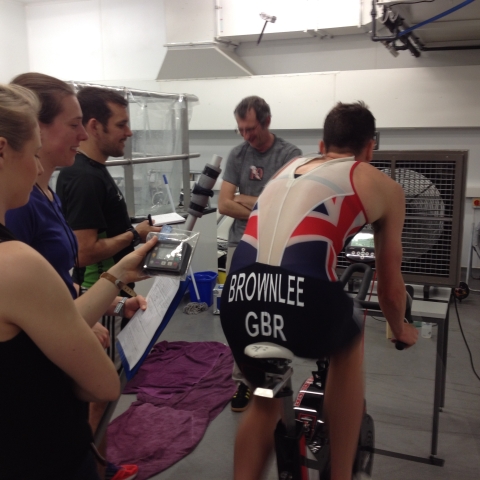
Working with elite triathlete Alistair Brownlee for the English Institute of Sport (UK Sports Institute).
On the world stage
The work of the EEL and its staff has received an enormous amount of global news coverage from the world’s biggest and high-profile media outlets such as BBC News, Sky News, The Times, CNN and the New York Times over its 25-year history. Some of the biggest names in sport, TV and even Hollywood have used the world-renowned facilities the EEL has to offer. This media interest is due to the work in extreme environments, the high-profile projects that have been conducted in the lab, and the different groups that have visited the lab. A lot of this work has been done “in the field” from the flight deck of aircraft to the seabed of the North Sea. From beaches, to oil rigs, to Lifeboat stations.
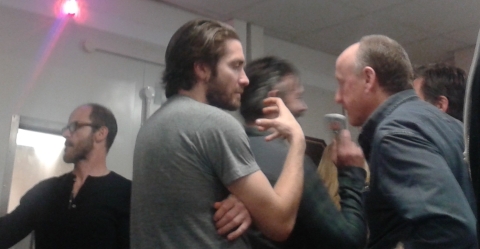
Jake Gyllenhall and Josh Brolin experienced the EEL in preparation for their roles in the film Everest.
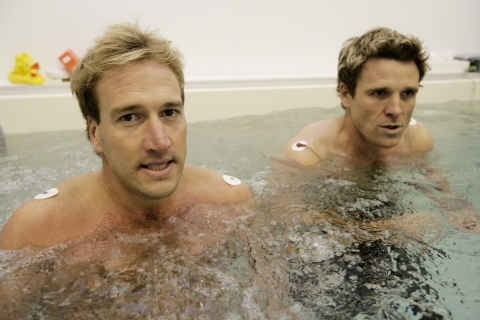
Ben Fogle and James Cracknell preparing ahead of their voyage across the Atlantic in a 24ft rowing boat.
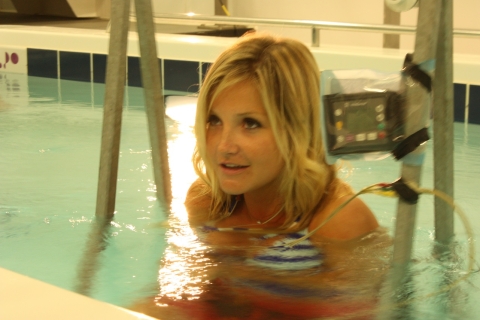
TV presenter Helen Skelton
A helping hand
EEL has been supported by many colleagues from many different areas of the University over the years – they all share in its achievements.
The group using EEL has grown somewhat since its inception a quarter of a century ago, at any one time around 10 full time staff, 7 PhD students, 2 technicians and 2 independent medical officers are involved with the laboratory.
External sponsors have included: the UK Medical Research Council; the Canadian Research Council; the Australian Research Council; the Slovenia Ministry of Science; the Japanese Research Council; the Health & Safety Executive; UK Ministry of Defence; Office of the Deputy Prime Minister; UK Home Office; Shell UK; London Underground; Kuwait Airline; Swedish MoD; Shark Group; the Royal National Lifeboat Institution; Decathlon, France; the International Maritime Contractors Association; WL Gore & Associates; UKSport; the English Institute of Sport; the Energy Institute; UK Coastguard; Maritime and Coastguard Agency; US Coastguard; Civil Aviation Authority; Defence Science and Technology Laboratory; Royal Society for the Prevention of Accidents; Scottish Sea Farms; Survitec PPE; Typhoon PPE; Beaufort PPE; Ocean Survivor PPE; BodyTrak Ltd; Kent Fire & Rescue Service; British Swimming; Royal Air Force; The Unseen; Millbrook Proving Ground; Clim8 Clothing; Felicity Ltd; Cryolabs Ltd; RWE Offshore Wind.
Over the years the work emanating from the EEL has won several awards, the latest is the inaugural award from The Physiological Society for “Excellence in Physiology” to be formally awarded in December 2023.
Here’s to the next 25 years!
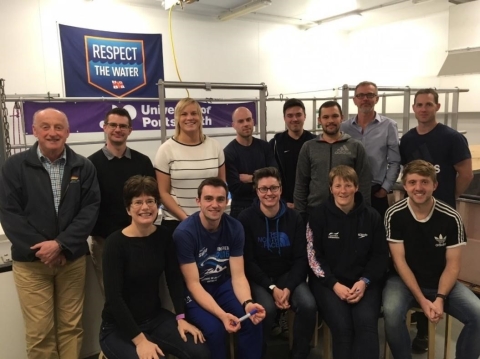
Some of those working in EEL in 2023.
The latest stories featuring EEL
New international guidelines will improve cystic fibrosis treatment
9 August 2023
8

Spinnaker Tower to turn blue for World Drowning Prevention Day
24 July 2023
6
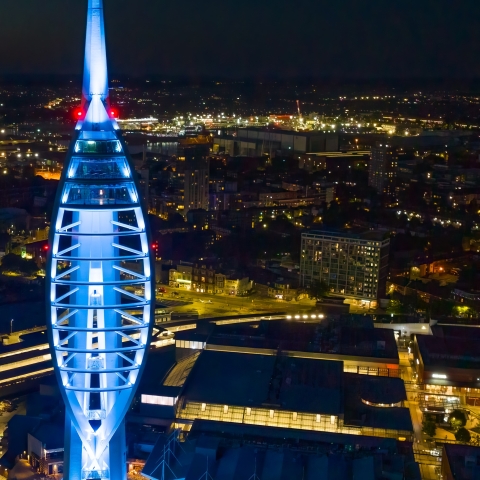
Recognition for live-saving physiological research
16 June 2023
3 minutes

